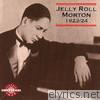
eLyrics J
Jelly Roll Morton Lyrics
Kansas City Stomp Lyrics
Total views: 1 time this week / Rating: 7.52/10 [21 votes]Album: Jelly Roll Morton 1923/24 / Original Release Date: 1992Genre: JazzSong Duration: 2 min 55 sec
Kansas City Stomp
Jelly Roll Morton
Jelly Roll Morton
JELLY ROLL MORTON
Kansas City Stomp Lyrics
That was the “Kansas City Stomp.” You may notice that
in playing jazz, the breaks are one of the most
essential things that you can ever do in jazz. Without
breaks and without clean breaks, without beautiful
ideas in breaks, you don’t need to even think about
doin’ anything else. If you can’t have a decent break,
you haven’t got a jazz band, or you can’t even play
jazz.
Show us a good break, Jelly.
Now that’s what you’d call a pretty good break. For
instance, I’ll play just a little bit of a melody of
somethin’ and show you.
That’s what you’d call a break . . .
Maybe I’d better play something that you can understand
more. For instance, “Strutters’ Ball.”
I made those blakes . . . breaks kind of clean, because
the fact of it is, everybody knows this tune and they
know how it’s played and they’ll know where the breaks
come in.
Without a break you have nothing. Even if a tune have
no break in it, it is always necessary to arrange some
kind of a spot to make a break. Because without a
break, as I said before, you haven’t gotten jazz . . .
and, er, your accurate tempos with your backgrounds of
your figures, which is called riffs today. Of course
that, that happens to be a musical term — riffs.
What’s the difference between a riff and a break?
Aren’t they about the same thing?
Oh, no, no. There’s a difference, er, a riff is a
background. A riff is what you would call a foundation,
as, like you would walk on. It’s something that’s
standard. And a break is something that you break. When
you make the break — that means all the band break,
with maybe one, two, or three instruments. It depends
upon how the combination is arranged. And as you, as
the band breaks, you have a set, given time, possibly
two bars, to make the break.
Isn’t . . . isn’t the break what you . . . when you,
when you make break, isn’t that what you mean by
swinging?
No, no, that’s not what swing is. Swing don’t mean
that. Swing means something like this:
in playing jazz, the breaks are one of the most
essential things that you can ever do in jazz. Without
breaks and without clean breaks, without beautiful
ideas in breaks, you don’t need to even think about
doin’ anything else. If you can’t have a decent break,
you haven’t got a jazz band, or you can’t even play
jazz.
Show us a good break, Jelly.
Now that’s what you’d call a pretty good break. For
instance, I’ll play just a little bit of a melody of
somethin’ and show you.
That’s what you’d call a break . . .
Maybe I’d better play something that you can understand
more. For instance, “Strutters’ Ball.”
I made those blakes . . . breaks kind of clean, because
the fact of it is, everybody knows this tune and they
know how it’s played and they’ll know where the breaks
come in.
Without a break you have nothing. Even if a tune have
no break in it, it is always necessary to arrange some
kind of a spot to make a break. Because without a
break, as I said before, you haven’t gotten jazz . . .
your figures, which is called riffs today. Of course
that, that happens to be a musical term — riffs.
What’s the difference between a riff and a break?
Aren’t they about the same thing?
Oh, no, no. There’s a difference, er, a riff is a
background. A riff is what you would call a foundation,
as, like you would walk on. It’s something that’s
standard. And a break is something that you break. When
you make the break — that means all the band break,
with maybe one, two, or three instruments. It depends
upon how the combination is arranged. And as you, as
the band breaks, you have a set, given time, possibly
two bars, to make the break.
Isn’t . . . isn’t the break what you . . . when you,
when you make break, isn’t that what you mean by
swinging?
No, no, that’s not what swing is. Swing don’t mean
that. Swing means something like this:

Hottest Lyrics with Videos
7ae19fc6c7840fb89fbf9abcbdff057f
check amazon for Kansas City Stomp mp3 download
these lyrics are submitted by kaan
Record Label(s): 1992 Fantasy, Inc
Official lyrics by
Meaning to "Kansas City Stomp" song lyrics



